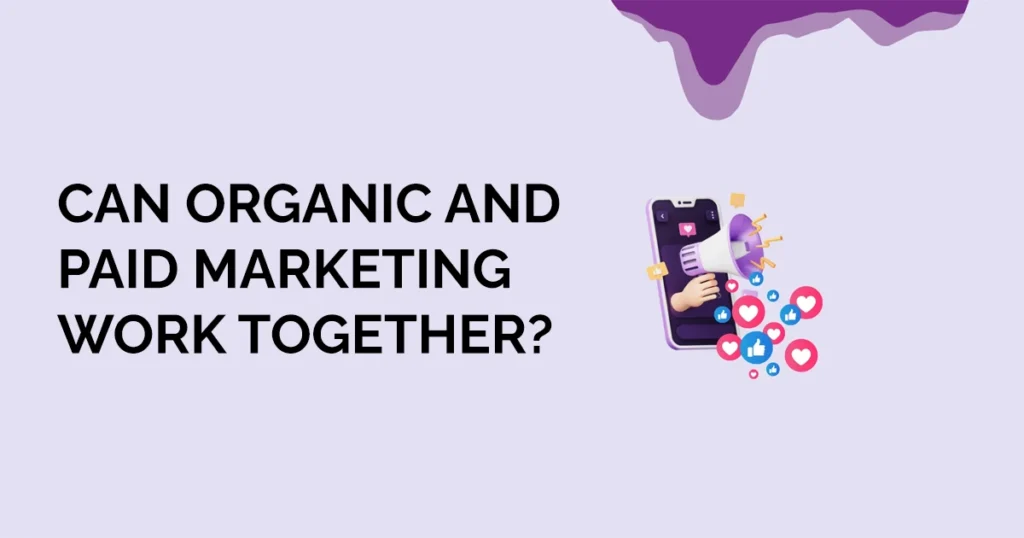In terms of business growth, organic vs paid marketing would date as a slow-burning romance-you spend time getting to know one another, gaining trust, and creating lasting bonds. In other words, paid marketing is like speed dating: you meet dozens of prospects in minutes, yet the connection survives only as long as the setup continues. Both tactics can build meaningful relationships, but the paths are so incredibly different.
The difference between organic and paid marketing discussion so important in 2025. One builds loyalty naturally for brands, while the other helps reach the right people quickly.
To even know what your business really needs-a mix of the two or one solely-you must strictly understand organic vs paid marketing and their strengths, limitations, and distinct roles in a fast-changing digital ecosystem.
What is Organic Marketing?
Organic leads are potential customers who find a business naturally without any paid advertising. For example, someone may search a query like “best accounting software for small businesses” and reach the company’s site through the search engine.
That is an organic lead. Generally, they tend to have high trust levels because the quest itself is a result of a genuine attempt rather than paid persuasion.
See also: How Do SEO Techniques Help to Grow Organic Traffic?
Key Strategies in Organic Marketing
- Search Engine Optimization (SEO): Optimizing web content on search engines.
- Content Marketing: Blogs, guides, eBooks, whitepapers, and videos that educate, engage.
- Social Media Engagement: Regular posting, answering comments, building communities free of ad spend.
- Email Marketing: List building of subscribers and consistent, value-rich newsletters.
- Referral Marketing: Driving customer advocacy through reviews, testimonials, and word-of-mouth.
Examples of Organic Marketing
- A piece of blog content that ranks on Google and steadily brings traffic for an extended time.
- A LinkedIn article places the CEO as an industry thought leader.
- An Instagram post by the brand becomes trending as relatable storytelling goes viral.
What is Paid Marketing?
Paid marketing means spending direct money to promote content, products, or services. It gives fast visibility and allows very granular targeting.
Since the representations of paid marketing techniques can sound annoying for a rapidly growing business, it can scale up these marketing techniques just like that.
See also: PPC Full Form & Importance in Digital Marketing: A Complete Guide for 2025
Common Paid Marketing Tactics
Ads on Google or Bing are put above the organic ones. Display Advertising: Banner and visual advertisements placed on websites. Paid Social Media Campaigns: boosted posts or sponsored advertisements through influencer co-marketing. Remarketing Ads: advertising to users who had at least some previous interaction with the brand.
How Paid Marketing Works
Most of the platforms are auction-based- Advertisers bid for placements according to keywords, demographics, or behaviours. Spending Clicks are a factor of reach and frequency, while targeting makes sure that messages reach particular audiences.
Clarifying Organic Ads vs Paid Ads
Actually, the term ‘organic ads’ is slightly misleading. In reality, there are no paid ‘organic ads.’ What organic advertising means in practice is the word-of-mouth kind of stuff that happens after a customer posts that he or she had a great customer experience. With paid ads, by contrast, direct expenditure guarantees placement.
Key Differences Between Organic and Paid Marketing
As for cost, in effect, intention, timing, and sustainability also differentiate the two.
Timeframe
- Organic Marketing: A marathon that may take months to yield results but offers multiplying benefits.
- Paid advertising: It is, on the other hand, a sprint. Immediate visibility while money flows in advertising.
Cost
- Investment in talent, content, and patience is needed for organic marketing, not direct ad spend.
- Paid marketing needs constant funds to continue providing benefits over time.
Targeting
- The organic model is limited by the algorithms dependent on audience behaviour in the narrow targeting available to marketers.
- Paid can reach specific targets down to the location: demographics, interests, and behaviour.
Longevity
- Organic designs keep bearing fruit continuously, even after the original investment.
- Paid strategies disappear instantly at the moment the budget halts.
Organic vs Paid Search
The fundamental differences between paid search and organic search distinguish how businesses can be represented on search engines.
- Organic search results-In short, organic are gained through SEO concerning relevance and authority.
- Paid results-showing as sponsored results at the top or bottom of the SERPs, are paid for through a PPC campaign.
An optimized website can achieve organic ranking, but PPC comes with immediate yet temporary gains in visibility. Most successful brands will invest in both channels simultaneously.
Organic vs Paid Social Media
Social media is important for the coming fights between organic and paid social media strategies.
- Organic social media: Posts made freely of cost and engagement strategies which depend on algorithms to gain visibility. Example: Instagram sharing internal stories of a brand.
- Paid social media: Ads and boosted content guaranteed to be visible to the preferred audience. Example: An ad on Facebook targeting urban professionals with interests specific to the user.
The two combined offer authenticity (organic) and reach (paid) into the space created by digital marketing.
Advantages and Disadvantages
Organic Marketing Advantages
- Establishes trust and credibility.
- Provides long-term visibility.
- Cost savings, if well established.
Organic Marketing Disadvantages
- Takes a long time to show results.
- Little option to target.
- Requires continuous effort and quality content.
Paid Marketing Advantages
- Immediate results.
- Highly targeted audience.
- Measurable and easy to optimize.
Paid Marketing Disadvantages
- Costs quite a bit in outfitting the feature industry.
- Results end as soon as funding ends.
- It might seem less authentic to one’s audience.
Can Organic and Paid Marketing Work Together?

Indeed, the best marketing strategies incorporate both of these methods, for example:
- Establishing credibility through SEO, while running PPC campaigns for high-value keywords.
- Promoting organically exciting social media posts, and boosting the best-performing content with ads.
- Building an audience through organic newsletters, while retargeting them with paid ads.
- That is what this synergy delivers for businesses: the short term traction-with long term sustainability.
ROI Considerations: Organic vs Paid Marketing
Against such a backdrop of analysis on organic marketing vs. paid marketing ROI, context becomes important.
- Organic marketing ROI: Higher in long run since costs have a higher correlation with one-off efforts rather than continuing spend.
- Paid marketing ROI: Appealing in the short run since returns are almost immediate; diminishing returns kick in without investment on a sustained basis.
The best option will depend on company goals, industry, and budget. For nascent companies with cash constraints, organic might be the way to go. Paid marketing can realize quicker ROI for product launches or seasonal campaigns.
See also: GEO vs SEO: Which One Should Your Business Prioritize?
Conclusion: Organic vs Paid Marketing
Nothing beats complementing marketing strategies. Organic marketing engenders trust for a brand by showcasing brand authority and loyalty, whereas paid marketing presents her clients with instantaneous visibility and conversions.
In 2025, the successful companies will have no monopoly of any marketing paradigm. On the contrary, these marketing paradigms will work together in an integrated fashion, such as SEO and storytelling through organic means, alongside paid campaigns reinforcing the aims of the organic ones.
At the end of the day, pure marketing is really about achieving some balance-being patient with organic and flexible for paid.
FAQs
Q1 What is the difference between paid marketing and organic marketing?
Organic marketing attracts audiences naturally, while paid marketing buys visibility through advertisements on search engines or social media.
Q2 Which one is better for businesses: organic or paid marketing?
Neither is universally better. Organic marketing builds credibility and long-term trust, while paid marketing delivers quick results. Choose based on business goals and resources.
Q3 What are some disadvantages of organic marketing?
Organic marketing is slower, resource-intensive, and provides limited control over targeting compared to paid campaigns.
Q4 Can organic and paid marketing work together?
Yes! A hybrid approach combining organic credibility with paid speed often delivers the best results.
Q5 What is the main aim of organic marketing?
The goal is to build audience trust, authority, and recognition without relying on paid advertisements.
Q6 Which gives better ROI: Organic or Paid marketing?
Organic marketing provides higher long-term ROI but is slower and resource-heavy, while paid marketing gives quicker returns but requires ongoing investment.





